Effect of Seasonal Flow Field on Inland Ship Emission Assessment: A Case Study of Ferry
Abstract
:1. Introduction
2. Literature Review
3. Methodology
3.1. Problem Statement and Solution Framework
3.2. Numerical Simulation of Water Flow
3.2.1. Governing Equation
3.2.2. Numerical Solution
3.3. Ship Speed Correction under the Flow Field Effect
3.4. Estimation Model for Inland Ship Exhaust Emissions
3.4.1. Model Optimization
3.4.2. Model Parameters
4. Case Study
4.1. Data Acquisition
4.2. Numerical Simulation Experiment of the Flow Field
4.2.1. Terrain and Grid Generation
4.2.2. Simulation Schemes and Parameter Settings
4.2.3. Model Validation
5. Results and Analysis
5.1. Results and Analysis of the Calculation of the Flow Field
5.2. Results and Analysis of the Seasonal Flow Field Effect on Ship Speed
5.3. Results and Analysis of the Seasonal Flow Field Effect on Emission Calculation
5.4. Analysis of the Effectiveness of the Improved Model
6. Conclusions
Author Contributions
Funding
Acknowledgments
Conflicts of Interest
References
- Zhang, Y.; Yang, X.; Brown, R.; Yang, L.; Morawska, L.; Ristovski, Z.; Fu, Q.; Huang, C. Shipping emissions and their impacts on air quality in China. Sci. Total Environ. 2017, 581, 186–198. [Google Scholar] [CrossRef] [PubMed]
- Feng, J.; Zhang, Y.; Li, S.; Mao, J.; Patton, A.P.; Zhou, Y.; Ma, W.; Liu, C.; Kan, H.; Huang, C.; et al. The influence of spatiality on shipping emissions, air quality and potential human exposure in the Yangtze River Delta/Shanghai, China. Atmos. Chem. Phys. 2019, 19, 6167–6183. [Google Scholar] [CrossRef] [Green Version]
- Chen, D.; Wang, X.; Li, Y.; Lang, J.; Zhou, Y.; Guo, X.; Zhao, Y. High-spatiotemporal-resolution ship emission inventory of China based on AIS data in 2014. Sci. Total Environ. 2017, 609, 776–787. [Google Scholar] [CrossRef] [PubMed]
- Jalkanen, J.P.; Johansson, L.; Kukkonen, J. A comprehensive inventory of ship traffic exhaust emissions in the European sea areas in 2011. Atmos. Chem. Phys. 2016, 16, 71–84. [Google Scholar] [CrossRef] [Green Version]
- Li, C.; Yuan, Z.; Ou, J.; Fan, X.; Ye, S.; Xiao, T.; Shi, Y.; Huang, Z.; Ng, S.K.; Zhong, Z.; et al. An AIS-based high-resolution ship emission inventory and its uncertainty in Pearl River Delta region, China. Sci. Total Environ. 2016, 573, 1–10. [Google Scholar] [CrossRef] [PubMed]
- El-Taybany, A.; Moustafa, M.M.; Mansour, M.; Tawfik, A.A. Quantification of the exhaust emissions from seagoing ships in Suez Canal waterway. Alex. Eng. J. 2019, 58, 19–25. [Google Scholar] [CrossRef]
- Chen, D.; Tian, X.; Lang, J.; Zhou, Y.; Li, Y.; Guo, X.; Wang, W.; Liu, B. The impact of ship emissions on PM2. 5 and the deposition of nitrogen and sulfur in Yangtze River Delta, China. Sci. Total Environ. 2019, 649, 1609–1619. [Google Scholar] [CrossRef]
- Wan, Z.; Zhou, X.; Zhang, Q.; Chen, J. Do ship emission control areas in China reduce sulfur dioxide concentrations in local air? A study on causal effect using the difference-in-difference model. Mar. Pollut. Bull. 2019, 149, 110506. [Google Scholar] [CrossRef]
- Nunes, R.A.; Alvim-Ferraz, M.C.; Martins, F.G.; Sousa, S.I. The activity-based methodology to assess ship emissions—A review. Environ. Pollut. 2017, 231, 87–103. [Google Scholar] [CrossRef]
- Jia, P.; Wang, Q.; Lu, X.; Zhang, B.; Li, C.; Li, S.; Li, S.; Wang, Y. Simulation of the effect of an oil refining project on the water environment using the MIKE 21 model. Phys. Chem. EarthParts A/B/C 2018, 103, 91–100. [Google Scholar] [CrossRef]
- Xu, M.J.; Yu, L.; Zhao, Y.W.; Li, M. The simulation of shallow reservoir eutrophication based on MIKE21: A case study of Douhe Reservoir in North China. Procedia Environ. Sci. 2012, 13, 1975–1988. [Google Scholar] [CrossRef] [Green Version]
- Song, S.; Shon, Z. Current and future emission estimates of exhaust gases and particles from shipping at the largest port in Korea. Environ. Sci. Pollut. Res. 2014, 21, 6612–6622. [Google Scholar] [CrossRef]
- Nielsen, O.K. EMEP/EEA Air Pollutant Emission Inventory Guidebook 2013: Technical Guidance to Prepare National Emission Inventories EEA Technical Report; EEA-European Environment Agency: Luxembourg, 2013; Volume 10, p. 92722. [Google Scholar]
- Miola, A.; Ciuffo, B. Estimating air emissions from ships: Meta-analysis of modelling approaches and available data sources. Atmos. Environ. 2011, 45, 2242–2251. [Google Scholar] [CrossRef]
- Liu, H.; Shang, Y.; Jin, X.X. Review of methods and progress on shipping emission inventory studies. Acta Sci. Circumstantiae 2018, 38, 1–11. (In Chinese) [Google Scholar] [CrossRef] [Green Version]
- Toscano, D.; Murena, F. Atmospheric ship emissions in ports: A review. Correlation with data of ship traffic. Atmos. Environ. X 2019, 4, 100050. [Google Scholar] [CrossRef]
- Jalkanen, J.P.; Brink, A.; Kalli, J.; Pettersson, H.; Kukkonen, J.; Stipa, T. A modelling system for the exhaust emissions of marine traffic and its application in the Baltic Sea area. Atmos. Chem. Phys. 2009, 9, 9209–9223. [Google Scholar] [CrossRef] [Green Version]
- Jalkanen, J.P.; Johansson, L.; Kukkonen, J.; Brink, A.; Kalli, J.; Stipa, T.; Kerminen, V.M. Extension of an assessment model of ship traffic exhaust emissions for particulate matter and carbon monoxide. Atmos. Chem. Phys. 2012, 12, 2641–2659. [Google Scholar] [CrossRef] [Green Version]
- Johansson, L.; Jalkanen, J.P.; Kukkonen, J. Global assessment of shipping emissions in 2015 on a high spatial and temporal resolution. Atmos. Environ. 2017, 167, 403–415. [Google Scholar] [CrossRef]
- Huang, L.; Wen, Y.; Geng, X.; Zhou, C.; Xiao, C. Integrating multi-source maritime information to estimate ship exhaust emissions under wind, wave and current conditions. Transp. Res. Part D Transp. Environ. 2018, 59, 148–159. [Google Scholar] [CrossRef]
- Zhang, Y.; Fung, J.C.; Chan, J.W.; Lau, A.K. The Significance of Incorporating Unidentified Vessels Into AIS-based Ship Emission Inventory. Atmos. Environ. 2019, 203, 102–113. [Google Scholar] [CrossRef]
- Huang, C.; Hu, Q.; Wang, H.; Qiao, L.; Wang, H.; Zhou, M.; Zhu, S.; Ma, Y.; Lou, S.; Li, L.; et al. Emission factors of particulate and gaseous compounds from a large cargo vessel operated under real-world conditions. Environ. Pollut. 2018, 242, 667–674. [Google Scholar] [CrossRef] [PubMed]
- Zhang, Y.; Gu, J.; Wang, W.; Peng, Y.; Wu, X.; Feng, X. Inland port vessel emissions inventory based on Ship Traffic Emission Assessment Model–Automatic Identification System. Adv. Mech. Eng. 2017, 9. [Google Scholar] [CrossRef]
- Van, L.T.; Macharis, C. Assessing the Environmental Impact of Inland Waterway Transport Using a Lifecycle Assessment Approach: The Case of Flanders. Res. Transp. Bus. Manag. 2014, 12, 29–40. [Google Scholar]
- Keuken, M.P.; Moerman, M.; Jonkers, J.; Hulskotte, J.; van der Gon, H.D.; Hoek, G.; Sokhi, R.S. Impact of inland shipping emissions on elemental carbon concentrations near waterways in The Netherlands. Atmos. Environ. 2014, 95, 1–9. [Google Scholar] [CrossRef]
- Sun, X.; Yan, X.; Wu, B.; Song, X. Analysis of the operational energy efficiency for inland river ships. Transp. Res. Part D Transp. Environ. 2013, 22, 34–39. [Google Scholar] [CrossRef]
- Wang, K.; Yan, X.; Yuan, Y.; Jiang, X.; Lin, X.; Negenborn, R.R. Dynamic optimization of ship energy efficiency considering time-varying environmental factors. Transp. Res. Part D Transp. Environ. 2018, 62, 685–698. [Google Scholar] [CrossRef]
- Cao, Y.L.; Wang, X.; Yin, C.Q.; Xu, W.W.; Shi, W.; Qian, G.R.; Xun, Z.M. Inland vessels emission inventory and the emission characteristics of the Beijing-Hangzhou Grand Canal in Jiangsu province. Process Saf. Environ. Prot. 2018, 113, 498–506. [Google Scholar] [CrossRef]
- Browning, L. Current Methodologies in Preparing Mobile Source Port-Related Emission Inventories; Final Report; US Environmental Protection Agency: Washington, DC, USA, 2009.
- Danish Hydraulic Institute (DHI). MKE21: A Modeling System for Rivers and Channels Reference Manual; DHI Water & Environment: Hørsholm, Demark, 2007; pp. 1–3. [Google Scholar]
- Xu, W.W.; Yin, C.Q.; Xu, X.J.; Zhang, W. Vessels Emission Inventory and Its Emission Characteristics on Inland River in Jiangsu Province. Environ. Sci. 2018, 40, 2595–2606. (In Chinese) [Google Scholar]
- Xiao, X.; Li, C.; Ye, X.; Wang, R.; Yu, K.; Xie, Y.; Liao, S.; Huang, Z.; Zheng, J. Emission characteristics of gas- and particle- phase pollutants from river vessels in cruising mode. Acta Sci. Circumstantiae 2019, 39, 13–24. (In Chinese) [Google Scholar]
- Zhang, F.; Chen, Y.; Cui, M.; Feng, Y.; Yang, X.; Chen, J.; Zhang, Y.; Gao, H.; Tian, C.; Matthias, V.; et al. Emission factors and environmental implication of organic pollutants in PM emitted from various vessels in China. Atmos. Environ. 2019, 200, 302–311. [Google Scholar] [CrossRef]
- IMO. Third IMO GHG Study 2014; International Maritime Organization (IMO): London, UK, 2014. [Google Scholar]

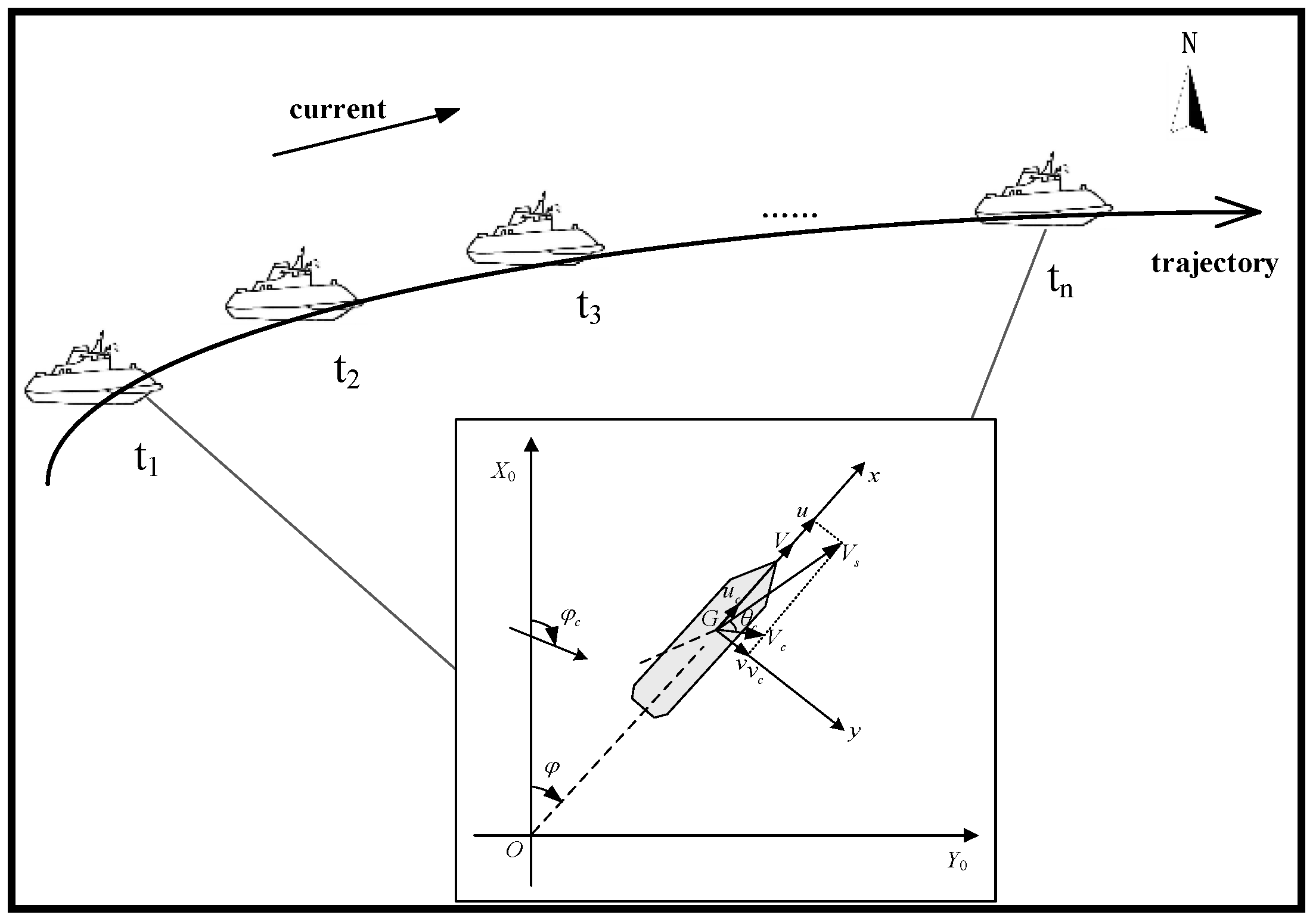
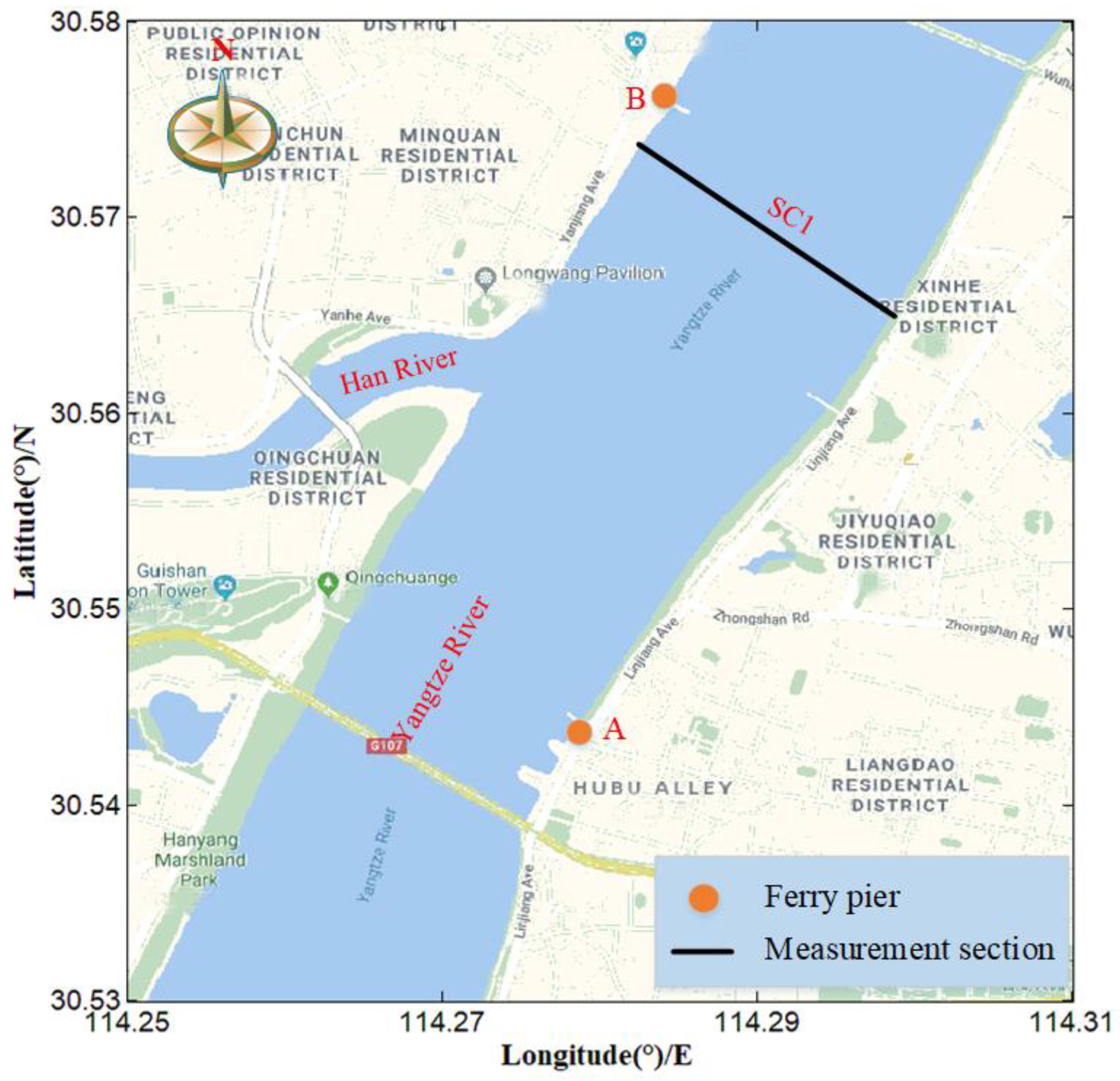
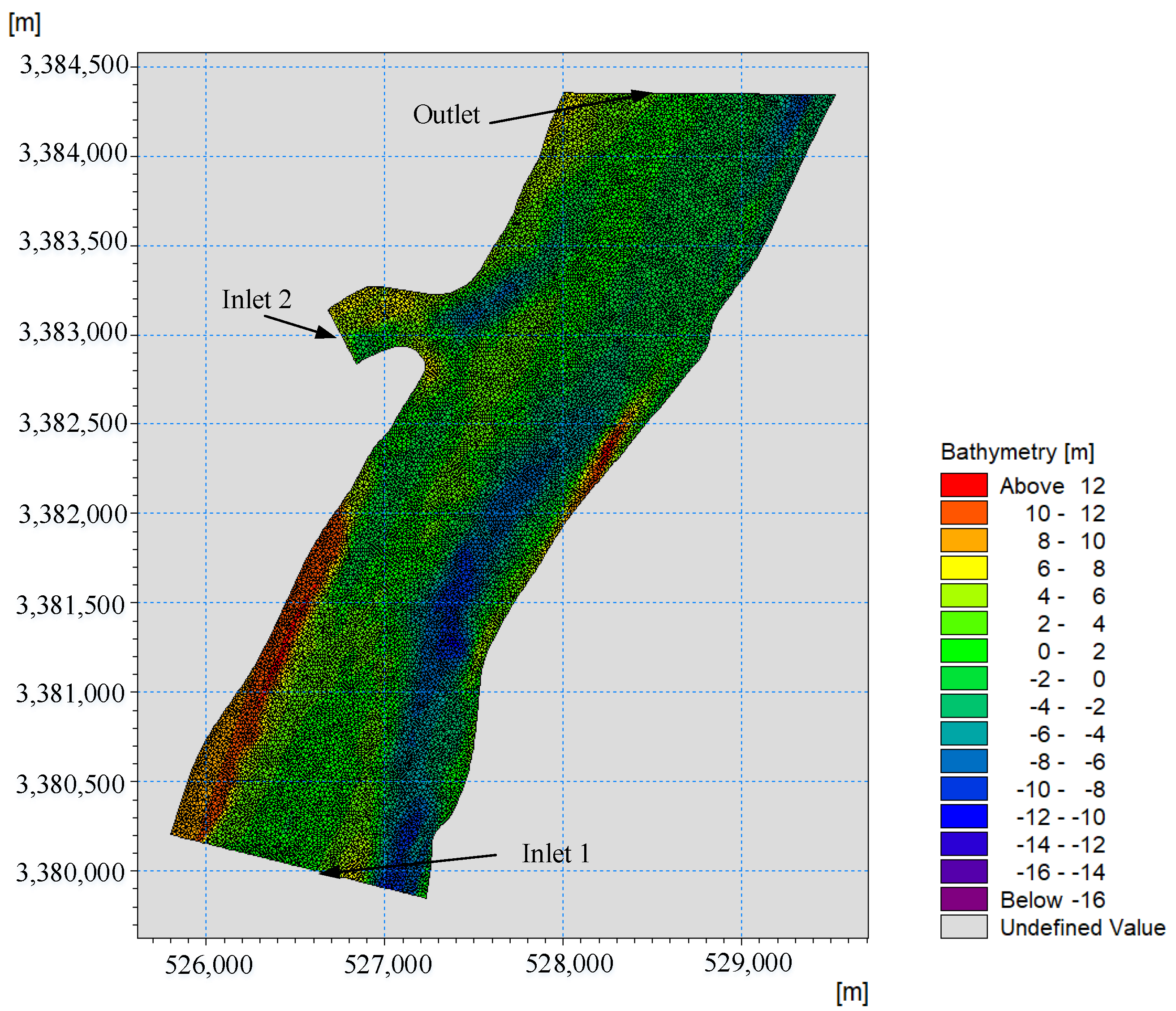
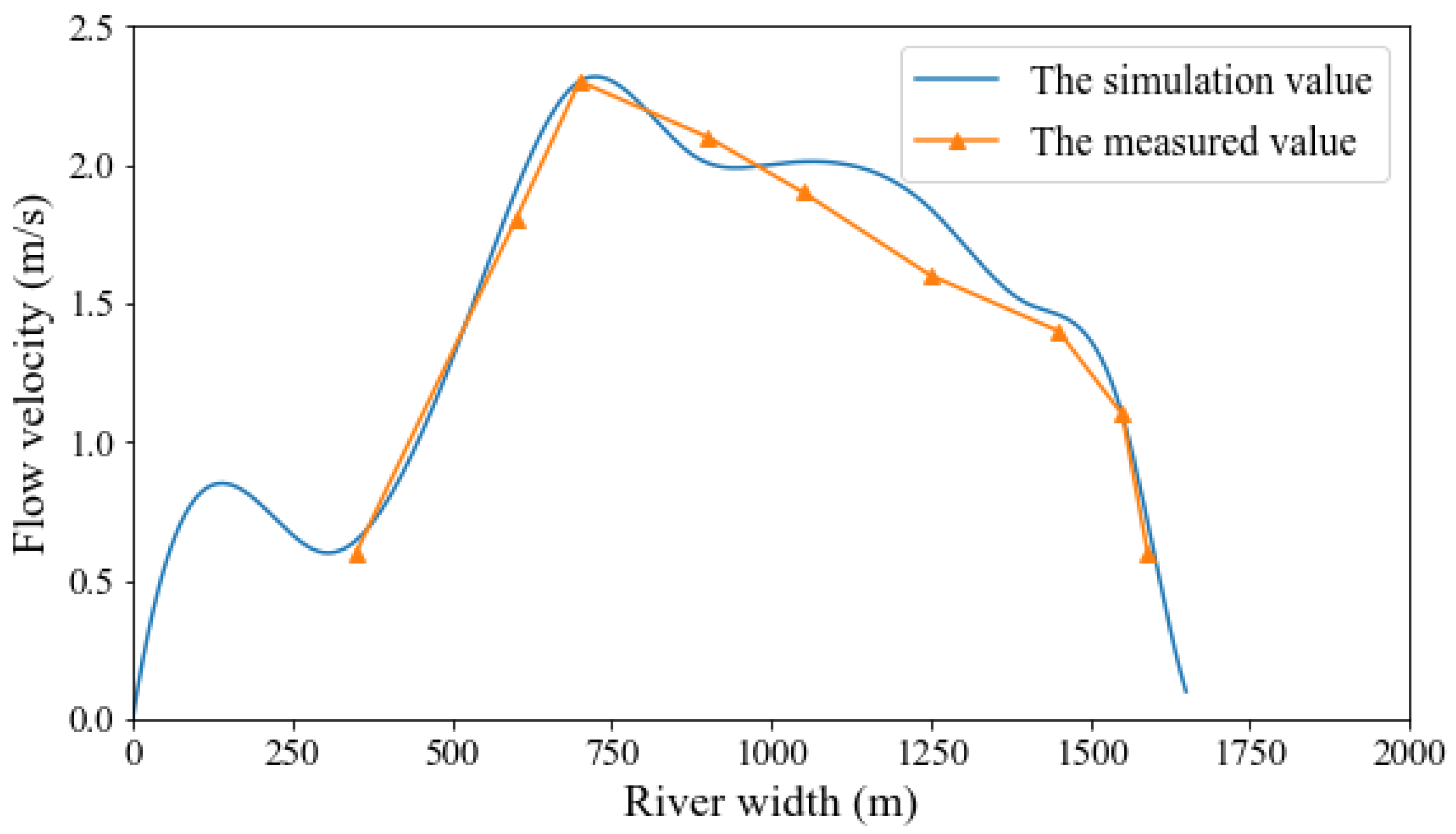
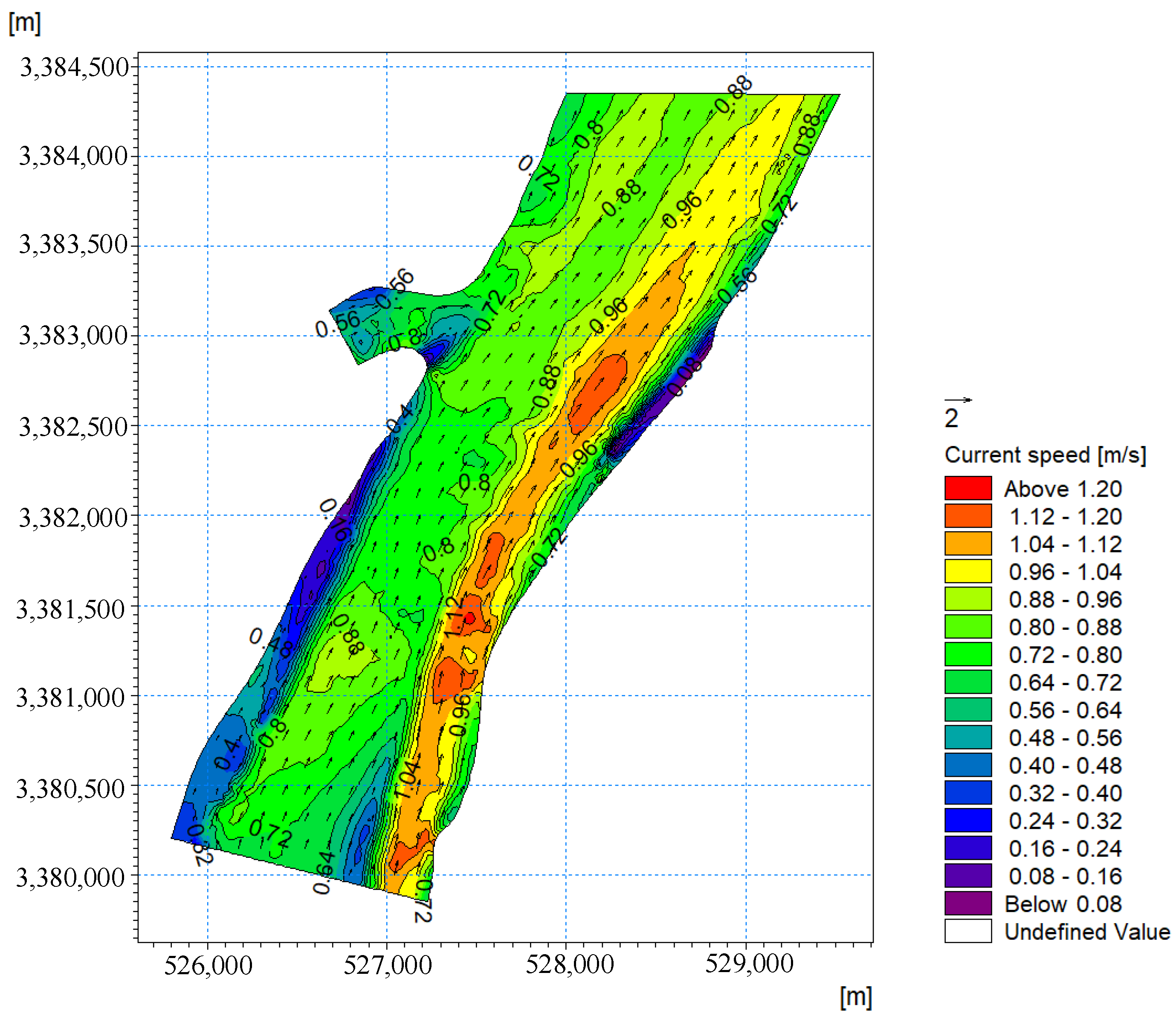

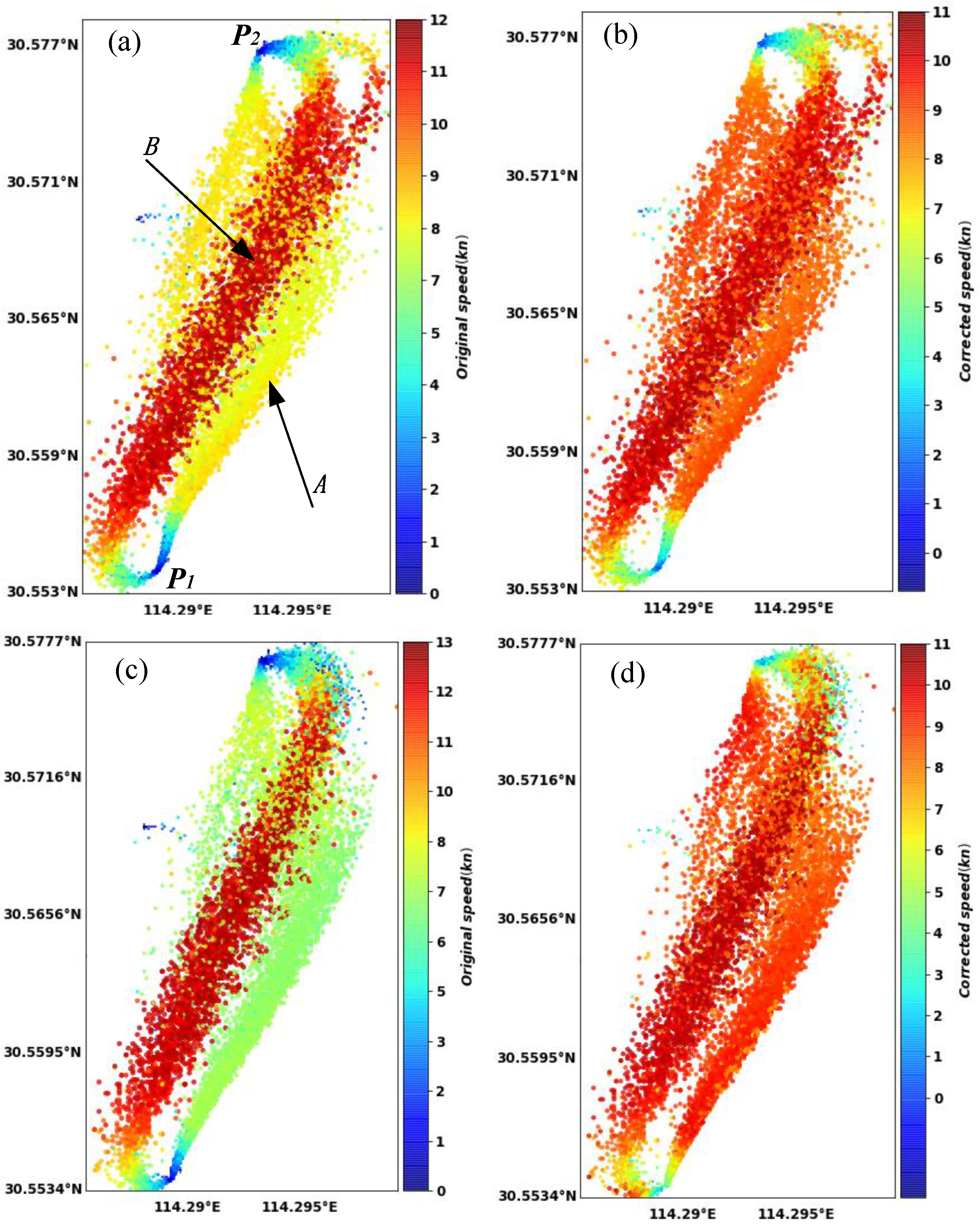
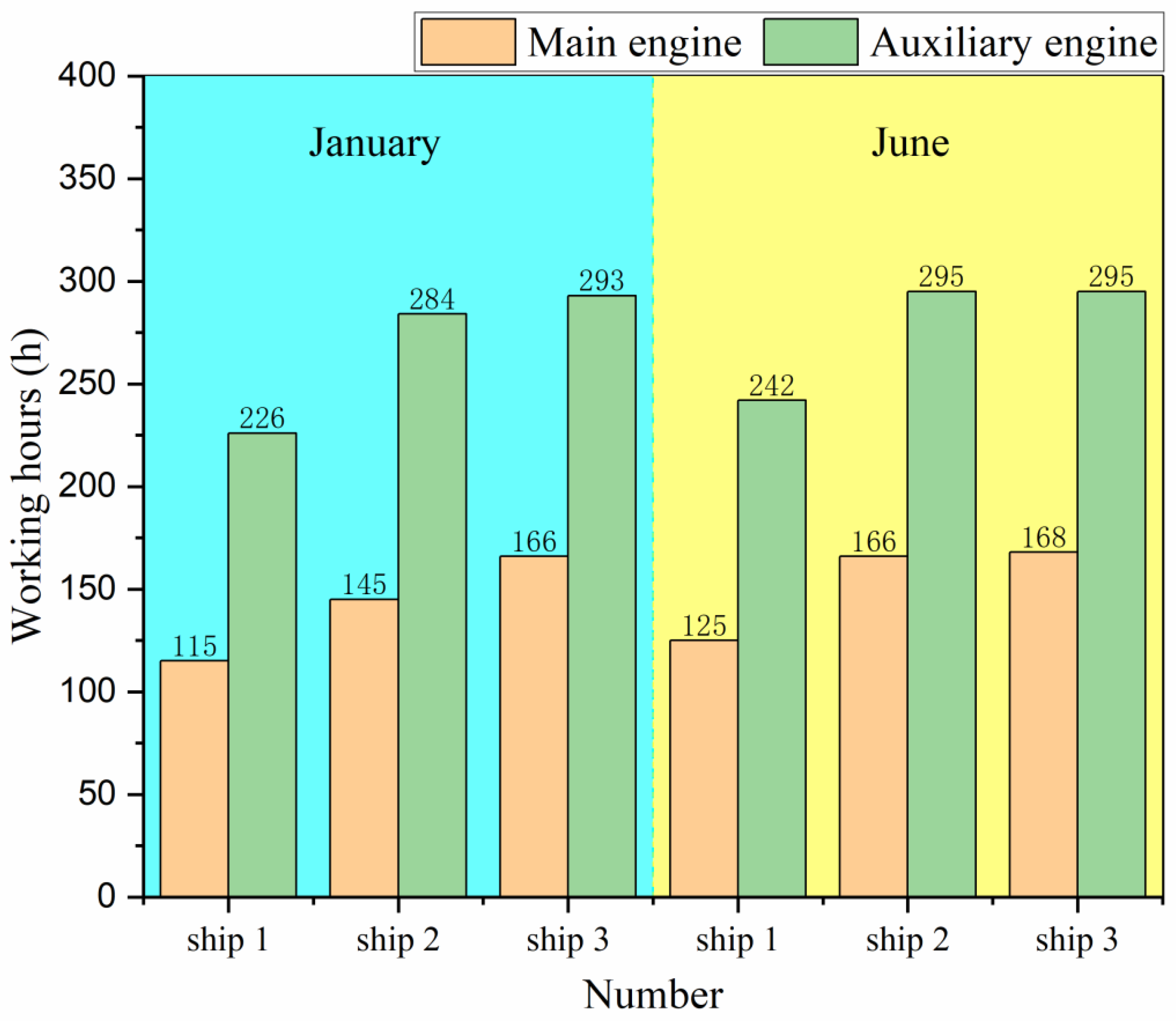
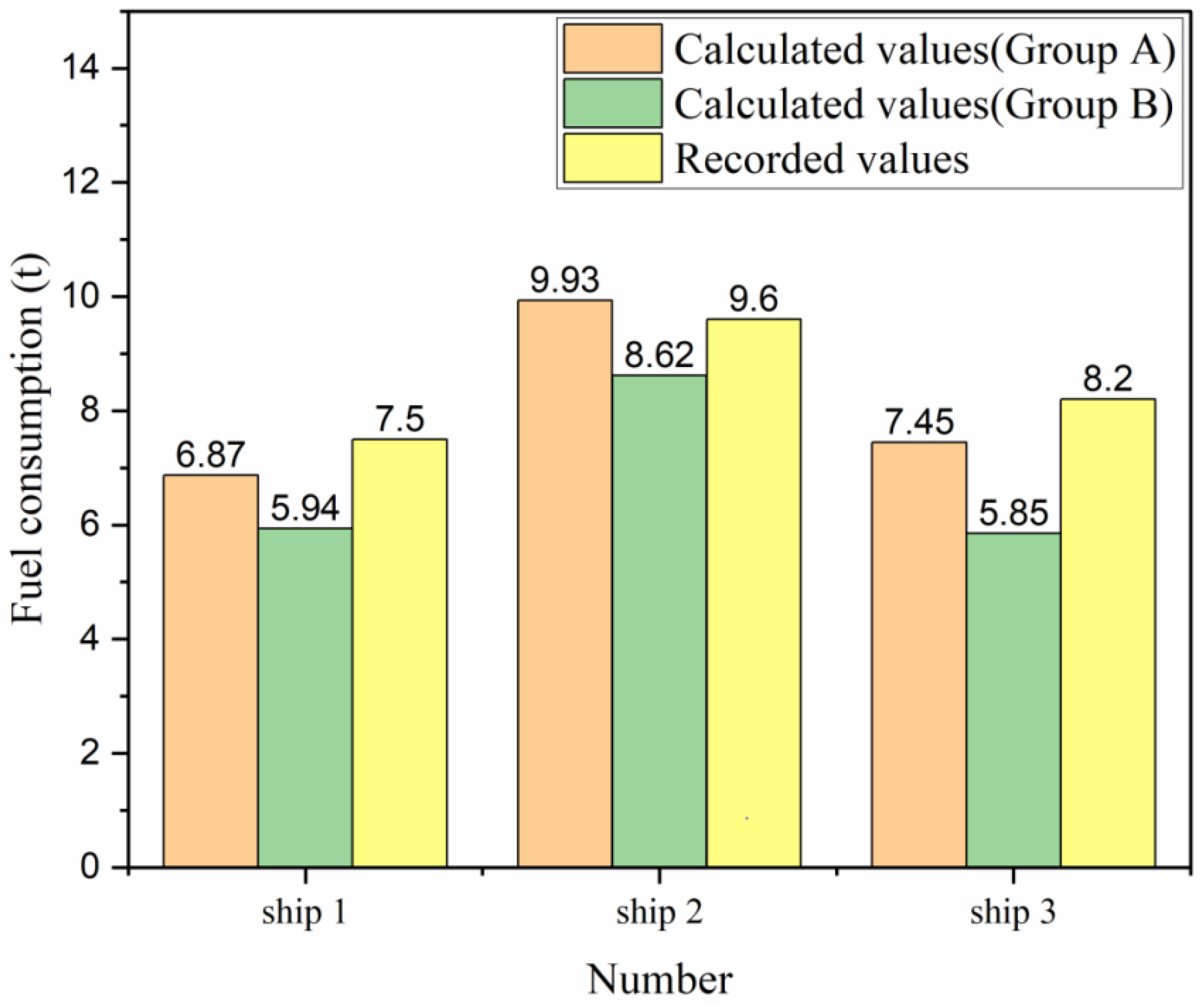
| Engine | Engine Type | Fuel Type | CO2 | SO2 | NOx | CO | PM2.5 |
|---|---|---|---|---|---|---|---|
| Main engine | HSDI | Diesel oil | 620 | 5.77 | 16.29 | 0.5 | 0.57 |
| Auxiliary engine | HSDI | Light oil | 690 | 2.12 | 12.0 | 1.1 | 0.29 |
| Parameters | Values |
|---|---|
| Length | 46 m |
| Width | 10 m |
| Gross tonnage | 400 t |
| Design sailing speed | 24 km/h |
| Main engine power | 220 kW × 2 |
| Auxiliary engine power | 120 + 60 kW |
| Engine rated speed | 1500 r/min |
| Water Season | Initial Conditions | Boundary Conditions | |||
|---|---|---|---|---|---|
| Water Level (m) | Initial Velocity (m/s) | Given Discharge of Inlet 1 (m3/s) | Given Discharge of Inlet 2 (m3/s) | Given Water Level of Outlet (m) | |
| January | 13.50 | 0 | 14,200 | 680 | 13.62 |
| June | 24.80 | 0 | 42,700 | 1610 | 24.82 |
| Number | MMSI | Group | CO2 | SO2 | NOx | CO | PM2.5 | Total | Error |
|---|---|---|---|---|---|---|---|---|---|
| Ship 1 | 413932544 | A | 19.419 | 0.130 | 0.438 | 0.023 | 0.014 | 20.024 | 1.28% |
| B | 19.173 | 0.127 | 0.431 | 0.022 | 0.014 | 19.768 | |||
| Ship 2 | 413932545 | A | 23.217 | 0.153 | 0.520 | 0.028 | 0.016 | 23.935 | 1.42% |
| B | 22.891 | 0.150 | 0.512 | 0.027 | 0.016 | 23.596 | |||
| Ship 3 | 413932548 | A | 25.148 | 0.166 | 0.563 | 0.030 | 0.018 | 25.925 | 1.61% |
| B | 24.746 | 0.162 | 0.553 | 0.029 | 0.017 | 25.507 |
| Number | MMSI | Group | CO2 | SO2 | NOx | CO | PM2.5 | Total | Error |
|---|---|---|---|---|---|---|---|---|---|
| Ship 1 | 413932544 | A | 21.380 | 0.143 | 0.482 | 0.025 | 0.015 | 22.045 | 13.64% |
| B | 18.481 | 0.116 | 0.406 | 0.023 | 0.013 | 19.039 | |||
| Ship 2 | 413932545 | A | 30.915 | 0.220 | 0.716 | 0.035 | 0.023 | 31.909 | 13.23% |
| B | 26.846 | 0.182 | 0.608 | 0.031 | 0.019 | 27.687 | |||
| Ship 3 | 413932548 | A | 23.206 | 0.167 | 0.540 | 0.026 | 0.017 | 23.957 | 21.64% |
| B | 18.208 | 0.121 | 0.409 | 0.021 | 0.013 | 18.772 |
© 2020 by the authors. Licensee MDPI, Basel, Switzerland. This article is an open access article distributed under the terms and conditions of the Creative Commons Attribution (CC BY) license (http://creativecommons.org/licenses/by/4.0/).
Share and Cite
Huang, H.; Zhou, C.; Xiao, C.; Huang, L.; Wen, Y.; Wang, J.; Peng, X. Effect of Seasonal Flow Field on Inland Ship Emission Assessment: A Case Study of Ferry. Sustainability 2020, 12, 7484. https://doi.org/10.3390/su12187484
Huang H, Zhou C, Xiao C, Huang L, Wen Y, Wang J, Peng X. Effect of Seasonal Flow Field on Inland Ship Emission Assessment: A Case Study of Ferry. Sustainability. 2020; 12(18):7484. https://doi.org/10.3390/su12187484
Chicago/Turabian StyleHuang, Hongxun, Chunhui Zhou, Changshi Xiao, Liang Huang, Yuanqiao Wen, Jianxin Wang, and Xin Peng. 2020. "Effect of Seasonal Flow Field on Inland Ship Emission Assessment: A Case Study of Ferry" Sustainability 12, no. 18: 7484. https://doi.org/10.3390/su12187484






